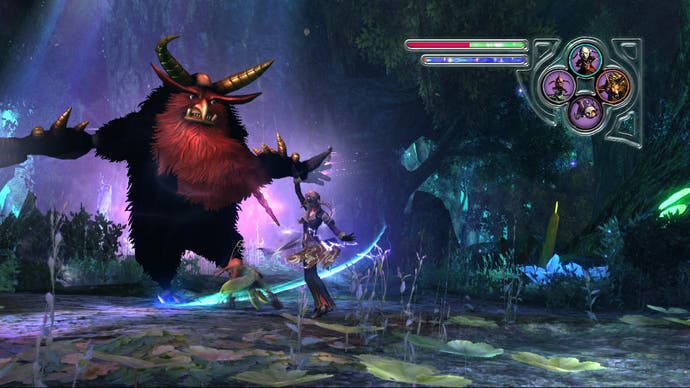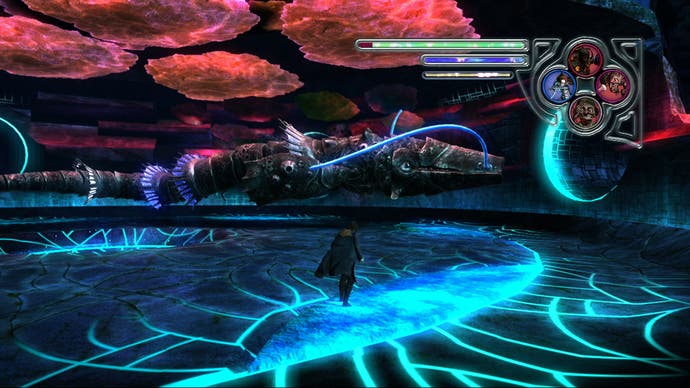Folklore
Folkssoul oh brother.
My mum was once the Rose of Cork. My dad taught Donal Lenihan how to play rugby. That's apropos of nothing other than to establish my credentials for reviewing a game set in Ireland (or Oirland as it's more commonly known in the videogame voice-acting community, with Folklore no exception).
But since we're talking about my mum, when she was a little girl, she used to play in the fairy rings around her grandmother's house - and Irish fairy rings aren't patches of mushrooms like they are in this country, but ancient burial mounds that are also the homes of faeries and the entrance to their magical realms.
And it's this world - the world of Celtic folklore and make-believe - that forms the starting point for Folklore. Except, since it's been developed under the guidance of Yoshiki Okamoto (of Onimusha, Devil May Cry and Resident Evil fame), it's got a vividly Japanese twist. One thing that is authentically Irish, though, is that it starts, as so many good Irish adventures do, down the pub. Taking on the role of either Keats, a writer for an occult magazine, or Ellen, a girl in search of her mother, you'll find yourself in the village of Lemrick, where the living meet the dead.

Which is a rather grandiose way of saying that you'll find yourself engaged in a pretty conventional adventure game: go round the village, talk to people, discover clues and so on and so forth. It's pretty boring, even when you discover that by night the pub is peopled with an amiable assortment of banshees and spirits and monsters listening to Danny Boy on the radio. But eventually your investigations lead you to the Fairy World, which is where the action really starts.
That action consists of proceeding along a fairly linear path, punctuated occasionally by safe areas where you can talk to the fairies if you so choose, or save the game, or go through a portal that returns you to places you've previously explored. Outside those safe areas, you'll spend your time fighting with fairies and spirits. The catch is that you use your Sixaxis to catch the souls of those spirits, and then you'll use those souls to fight other spirits.

The combat system allows you to map each newly acquired soul to one of the four face buttons, which you then press to use those souls to attack other folk. When they're reeling from your attacks you reel them in by holding R1 and shaking the Sixaxis. Then you're free to map your newly acquired soul to one of the face buttons and so on.
Clearly, then, there's also a gotta-catch-'em all sort of thing going on here, as well as the bland adventuring and pretty standard dungeon crawling. But like those two parts of the game, the Pokémon-lite mechanic doesn't quite work. That's because all of the attacks enabled by captured folk souls are pretty similar. One or two allow you to block, or provide ranged/aerial attacks, but the vast majority are simply variations on the standard attack. If it weren't for the fact that some folk are only vulnerable to certain other folk, you'd never really need to swap them over - and the fact that some folk are only vulnerable to certain other folk feels a bit like a contrived way of providing an incentive to catch 'em all.

Certainly you wouldn't want to swap them over otherwise, because when you do, it gets confusing trying to remember which folk you've got mapped to which face button. But the real drawback with the controls is the whole Sixaxis thing. Indeed, with Sony publishing the game itself, it's difficult not to see Folklore as little more than a contrived attempt to build a game mechanic around the controller, which is a shame because the Sixaxis dynamic is frequently annoying, occasionally imprecise, and utterly tedious when you get to some of the tougher folk, because they require even more shaking than usual.
And so Folklore turns out to be one part boring adventure game, one part underdeveloped collect-em up, and one part standard dungeon crawl. The only aspect of the game that rises above the mundane is its technical polish and the vibrant creativity with which its imaginary worlds have been created - the vivid luminescence of the Fairy World, or the scratchy, Ian Miller-esque authenticity of the War World for example. Apart from that, it's totally average (and in case you're thinking of importing: if you don't read kanji you'll need a translator or to wait for the US/UK version, because the occasional - impressive - cut-scenes are the only bits in English).
